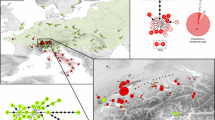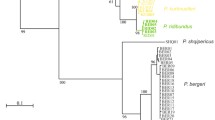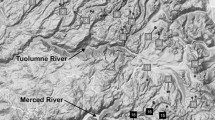Abstract
The recent genetic screening of water frogs (genus Pelophylax) in Belgium has shown that the invasion of two water frog species from Eastern Europe and the Mediterranean region, P. ridibundus and P. cf. bedriagae is widespread. Possibly other exotic water frogs are invading and establishing themselves through commercial trade. We used a genetic identification approach to rapidly detect and identify morphologically cryptic exotic water frog species in a large number of populations throughout the northern part of Belgium. Among a total of 944 individuals, we found 506 non-indigenous specimens, seven of which belonged to species not recorded before with certainty in Belgium or neighbouring regions in the wild. One of them was identified genetically as the Iberian green frog (P. perezi), but was most likely a P. perezi × P. esculentus hybrid. Six individuals of the Levantine frog (P. bedriagae) were found in a pond in the vicinity of a pet shop where the species is sold. All other exotic frogs belonged to four different haplotypes of P. ridibundus, established in Belgium since c. 1970, and two haplotypes of P. cf. bedriagae, a poorly-known eastern Mediterranean sister species of the latter. Overall, our study underscores the extent of exotic water frog invasions associated with the pet trade. Although two of the exotic species were recorded in small numbers, their early detection is essential with regards to adequate control and eradication of invasive species.
Similar content being viewed by others
References
Berger L, Speare R, Hyatt AD (1999) Chytrid fungi and amphibian declines: overview, implications and future directions. In: Campbell A (ed) Declines and disappearances of Australian frogs. Environment Australia, Canberra
Burny J, Parent GH (1985) Les grenouilles vertes de la Belgique et des régions limitrophes. Données chorologiques et écologiques. Alytes 4:12–33
Ficetola G, Coïc C, Detaint M, Berroneau M, Lorvelec O, Miaud C (2007) Pattern of distribution of the American bullfrog Rana catesbeiana in Europe. Biol Invasions 9:767–772
Fisher MC, Garner TWJ (2007) The relationship between the emergence of Batrachochytrium dendrobatidis, the international trade in amphibians and introduced amphibian species. Fungal Biol Rev 21:2–9
Holsbeek G, Jooris R (2009) Potential impact of genome exclusion by alien species in the hybridogenetic water frogs (Pelophylax esculentus complex). Biol Invasions. doi:10.1007/s10530-009-9427-2
Holsbeek G, Mergeay J, Hotz H, Plötner J, Volckaert FAM, De Meester L (2008) A cryptic invasion within an invasion and widespread introgression in the European water frog complex: the toll of uncontrolled commercial trade and weak international legislation. Mol Ecol 17:5023–5035
Holsbeek G, Maes GE, De Meester L, Volckaert FAM (2009) Conservation of the introgressed European water frog complex using molecular tools. Mol Ecol 18:1071–1087
Hulselmans J (1978) Morfologische gegevens betreffende ‘Rana esculenta’ in België (Anura, Ranidae). Ann Soc R Zool Belg 108:151–158
Kok P, Jooris R, Percsy C, Lenglet G (2002) Dangers pour la faune indigène de l’introduction d’espèces animales à des fins ornementales: Rana bedriagae (Amphibia: Anura: Ranidae), un futur cas d’école? Bull Inst R Sci Nat Belg 72:219–221
Lymberakis P, Poulakakis N, Manthalou G, Tsigenopoulos CS, Magoulas A, Mylonas M (2007) Mitochondrial phylogeography of Rana (Pelophylax) populations in the Eastern Mediterranean region. Mol Phylogenet Evol 44:115–125
Mergeay J (2009) The Rio Convention, CITES, European legislation and invasive amphibians: are we doomed to lag behind forever? Froglog 90:8–12
Pagano A, Lodé T, Crochet PA (2001) New contact zone and assemblages among water frogs of Southern France. J Zoolog Syst Evol Res 39:63–67
Pagano A, Dubois A, Lesbarreres D, Lodé T (2003) Frog alien species: a way for genetic invasion? C R Biol 326:S85–S92
Percsy C, Percsy N (2002a) Dix ans de suivi des populations indigènes et introduites de grenouilles “verte” (Rana (Pelophylax) ssp., Anura, Ranidae) dans le bassin de la Lasne (Brabant wallon, Belgique). Bull Soc Herpetol France 103:59–72
Percsy C, Percsy N (2002b) Evolution des populations indigènes et introduites de grenouilles “verte” en Brabant wallon. Bull Inst R Sci Nat Belg 72:213–217
Plötner J (2005) Die westpaläarktischen Wasserfrösche von Märtyrern der Wissenschaft zur biologischen Sensation. Laurenti-Verlag, Bielefeld, 160 pp
Plötner J, Uzzell T, Beerli P, Spolsky C, Ohst T, Litvinchuk SN, Guex GD, Reyer HU, Hotz H (2008) Widespread unidirectional transfer of mitochondrial DNA: a case in western Palaearctic water frogs. J Evol Biol 21:668–681
Schlaepfer MA, Hoover C, Dodd CK Jr (2005) Challenges in evaluating the impact of the trade in amphibians and reptiles on wild populations. Bioscience 55:256–264
Schmeller DS, Pagano A, Plenet S, Veith M (2007) Introducing water frogs—is there a risk for indigenous species in France? C R Biol 330:684–690
Shirley SM, Kark S (2006) Amassing efforts against alien invasive species in Europe. PLoS Biol 4(8):e279
Spolsky C, Uzzell T (1986) Evolutionary history of the hybridogenetic hybrid frog Rana esculenta as deduced from mtDNA analyses. Mol Biol Evol 3:44–56
Tamura K, Dudley J, Nei M, Kumar S (2007) MEGA4: molecular evolutionary genetics analysis (MEGA) software version 4.0. Mol Biol Evol 24:1596–1599
Acknowledgements
We thank R. Jooris for field assistance, and B. Hellemans for laboratory advise. G.H. enjoys a Ph.D. grant of the Institute for the Promotion of Innovation through Science and Technology in Flanders (IWT-Vlaanderen), and J.M. is a postdoctoral fellow of the Research Foundation—Flanders (FWO-Vlaanderen).
Author information
Authors and Affiliations
Corresponding author
Rights and permissions
About this article
Cite this article
Holsbeek, G., Mergeay, J., Volckaert, F.A.M. et al. Genetic detection of multiple exotic water frog species in Belgium illustrates the need for monitoring and immediate action. Biol Invasions 12, 1459–1463 (2010). https://doi.org/10.1007/s10530-009-9570-9
Received:
Accepted:
Published:
Issue Date:
DOI: https://doi.org/10.1007/s10530-009-9570-9




